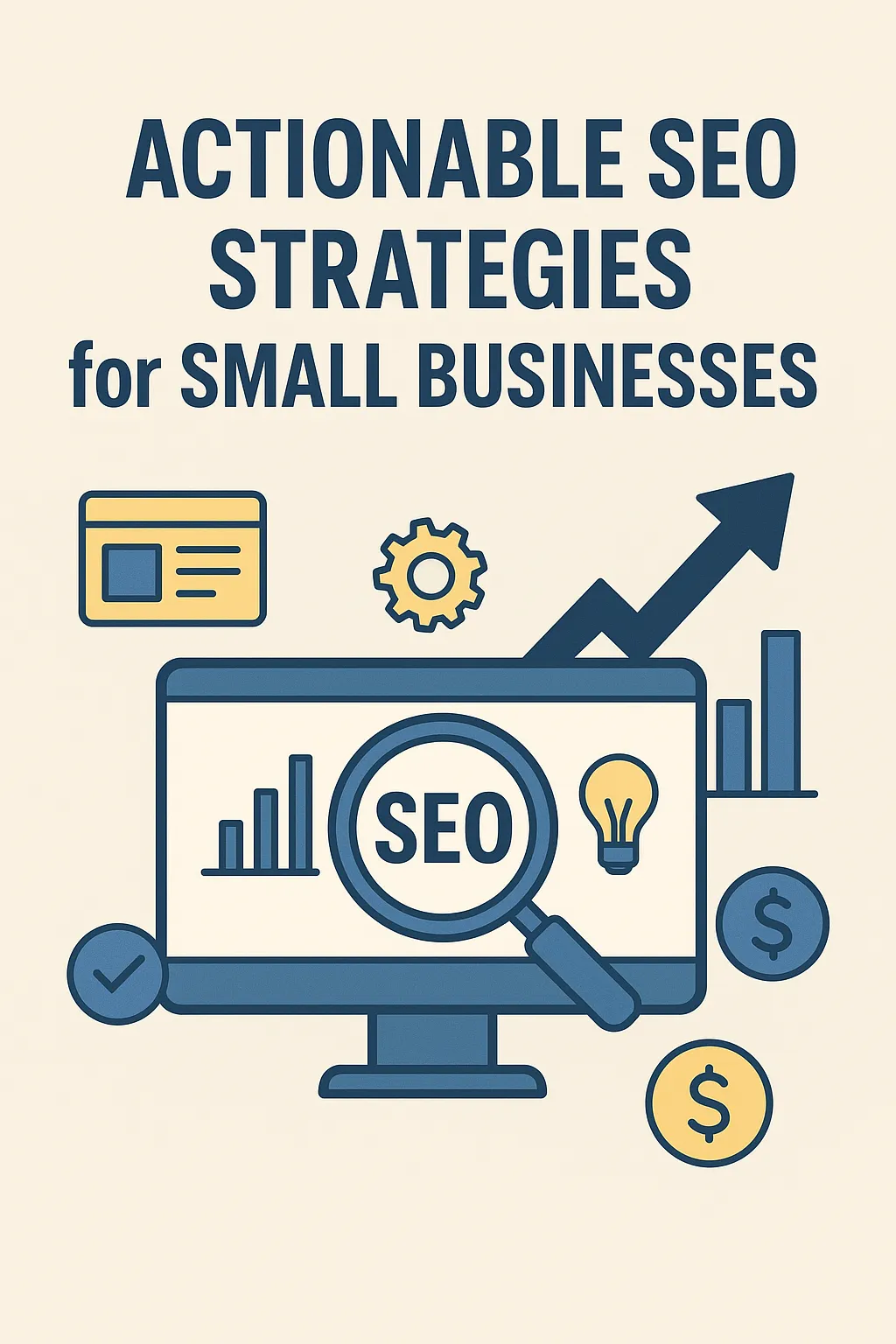- 1. Set Up Google Analytics and Google Search Console
- 2. Claim and Optimize Your Google Business Profile
- 3. Conduct Local Keyword Research
- 4. Analyze Your SERP Competitors
- 5. Provide Clear Product & Service Information
- 6. Implement Schema Markup
- 7. Optimize On-Page SEO Elements
- 8. Fix Common SEO Issues
- 9. Build High-Quality Backlinks
- 10. Collect and Respond to Customer Reviews
- 11. Build and Maintain Local Citations
- 12. Create Localized Content
- 13. Showcase Testimonials on Your Website
- 14. Improve Site Speed and Mobile Experience
- 15. Keep Your Website Fresh and Updated
Running a small business in today’s digital era means competing not just locally but online. The good news? With smart SEO strategies, you can attract qualified leads, rank higher on Google, and grow without huge advertising budgets. This guide breaks down 15 Actionable SEO Strategies for Small Businesses — practical, results-driven tips that help you build long-term visibility, trust, and customer loyalty.

1. Set Up Google Analytics and Google Search Console
Before improving SEO, you need to track what’s happening on your website.
- Google Analytics helps you understand traffic sources, visitor behavior, and top-performing pages.
- Google Search Console shows which keywords bring traffic, index coverage, and errors affecting your site’s visibility.
Add your tracking code, verify ownership, and submit an XML sitemap. Regular insights help you identify issues early and refine your SEO strategy.
2. Claim and Optimize Your Google Business Profile
Your Google Business Profile (GBP) is a free, powerful tool for local SEO. It helps customers find you on Google Search and Maps.
Include accurate NAP (Name, Address, Phone Number)
Add photos, updates, and services
Respond to every review
A fully optimized GBP increases your chances of appearing in the “Local Pack,” driving both online and foot traffic.
3. Conduct Local Keyword Research
Keyword research shows what your customers actually search for.
Use Google Keyword Planner, Ahrefs, or Moz to discover local and niche keywords like:
“best coffee shop in Boston” or “affordable plumber near me.”
Focus on long-tail and intent-based keywords — they bring more qualified leads and face less competition.
4. Analyze Your SERP Competitors
Studying competitors helps you see what’s working in your niche.
Search your target keywords on Google, then evaluate top-ranking sites for:
- Content quality and format
- Titles and meta descriptions
- Page structure and backlink sources
Use insights to improve your pages — not copy them. Your goal is to provide more value and a better user experience.
5. Provide Clear Product & Service Information
Every product or service page should explain what you offer, why it’s valuable, and how to buy it.
Include:
- Keyword-rich titles and descriptions
- Benefits and unique selling points
- Internal links to related content
Well-written, useful information keeps visitors engaged — and that’s great for SEO.
6. Implement Schema Markup
Schema markup helps search engines display rich snippets such as ratings, prices, and FAQs.
Adding schema:
- Improves click-through rates
- Makes listings more informative
- Strengthens local SEO signals
You can easily add schema using plugins like Rank Math or Yoast SEO
7. Optimize On-Page SEO Elements
Strong on-page SEO tells Google what your content is about. Focus on:
- Title tags: 55–60 characters, include target keywords.
- Meta descriptions: Compelling, under 160 characters.
- Headers (H1–H3): Organize and include secondary keywords.
- URLs: Keep short and descriptive (e.g., example.com/vegan-cupcakes).
Use clear headings, visuals, and CTAs to improve user experience.
8. Fix Common SEO Issues
A technically healthy website performs better in rankings. Regularly check for:
- Broken links
- Duplicate content
- Slow load speeds
- Missing alt text
- Poor mobile optimization
Tools like Google Search Console, Ahrefs, or Screaming Frog can help you detect and fix these issues efficiently.
9. Build High-Quality Backlinks
Backlinks are still one of Google’s top ranking factors.
Get links by:
- Listing your business in relevant directories
- Writing guest posts for reputable blogs
- Collaborating with local partners
Avoid spammy or irrelevant links — focus on quality and authority instead.
10. Collect and Respond to Customer Reviews
Positive reviews increase both trust and visibility.
Encourage satisfied customers to leave reviews on Google, Yelp, or Facebook.Then, reply to each one — thank happy customers and address concerns politely.
Engagement signals to Google that your business is active and customer-focused.
11. Build and Maintain Local Citations
Local citations (mentions of your name, address, and phone) help Google verify your business location.
List your business consistently on:
- Google Maps
- Yelp
- Yellow Pages
- Industry-specific directories
Use tools like Moz Local or BrightLocal to manage your citations easily.
12. Create Localized Content
Creating content relevant to your area improves local search rankings.
Ideas include:
- Blog posts about community events
- Guides for your city or neighborhood
- Customer stories or collaborations
Example: “Top 5 Coffee Spots in Austin You Should Visit This Weekend.”
Local content helps you connect directly with your nearby audience.
13. Showcase Testimonials on Your Website
Customer testimonials build social proof and credibility.
Feature them prominently on your homepage, service pages, or as a dedicated “Reviews” section.
Authentic testimonials improve engagement and conversions — while also adding keyword-rich, natural text for SEO.
14. Improve Site Speed and Mobile Experience
A slow website can drive visitors away before they even see your content.
- Compress images
- Use caching
- Optimize for mobile devices
Remember: Google now uses mobile-first indexing, so your mobile version determines your rankings.
15. Keep Your Website Fresh and Updated
SEO is an ongoing process — not a one-time setup.
Regularly update your website with:
- New blog posts
- Updated service details
- Seasonal or trending topics
Fresh, relevant content tells search engines your site is active and valuable to users.

Investing in SEO helps small businesses grow organically, build credibility, and compete with larger brands.
By optimizing your Google Business Profile, fixing technical issues, earning backlinks, and publishing localized content, you can boost both visibility and conversions.
Stay consistent, monitor your results, and adapt to new trends — that’s the key to sustainable SEO success in 2025 and beyond. Want to take your strategy even further? Read the Ultimate Guide to Digital Marketing for Small Businesses to learn how SEO fits into a complete growth plan.

